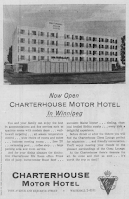© 2023, Christian Cassidy
Place: Charterhouse Motor Hotel / Charter House Hotel
Address: 330 York Avenue
Opened: April 1960
Architect: Waisman Ross and Associates
Builder: Ackman and Sons
Hotel Corporation of America (HCA), the third largest hotel chain in North America at the time, announced in June 1959 that it would open a high-end motor hotel in downtown Winnipeg under its Charterhouse brand located in dozens of cities in the U.S..
Motor hotels were a new breed of hostelry introduced in the late 1950s. They combined the advantages of motels, such as a smaller scale building and quick access to one's vehicle, with the amenities of large downtown hotels, like lounges and banquet facilities.
The size of these motor hotels and their amenities made them perfect for rapidly growing suburbs. Some suburban examples in Winnipeg from this time include the Curtis Gordon, Curtis Assiniboine, both of which opened in 1963, and the Lincoln Motor Hotel from 1964.
Motor Hotels also found their way in and around downtown to compete directly with the big railway-era hotels. The first of these to open was The Downtowner in July 1959. After the Charterhouse in 1960 came the Carlton Motor Inn in 1961, then the Osborne Village Motor Inn and Westminster Motor Hotel in 1964.
A consortium of local businessmen known as Broadway Hotels Ltd. owned the land and began construction of the $1.5 million building in spring 1959. In mid-June it was announced that the group signed a long-term lease with HCA to operate the hotel as a Charterhouse Motor Hotel.
The Charterhouse brand was a step-up from most motor hotels and were meant to appeal to business travellers who expected the services of a big hotel, such as bellboys, doormen, and a variety of meeting spaces, while being in the heart of the business district.

March 24, 1960, Winnipeg Tribune
"Now Open" ads for the Charterhouse Motor Hotel began appearing in newspapers on March 24, 1960.
Its 95 rooms featured air conditioning, TV and radio, and a bathroom with a full tub and shower. These may seem like basic amenities, but the old railway-era downtown hotels did not have AC and things like televisions and showers were retrofitted into spaces that weren't built to hold them.
The Rib Room restaurant, which was also part of the HCA Charterhouse brand, began advertising in April. Not only did it offer dinner around its open hearth fireplace, but there was also a lighter fare weekday businessman's luncheon that cost $1.65.
The cocktail lounge was initially known as the Chess Lounge and became the Char Bar in the 1970s. it featured live music - usually a pianist during the week and a jazz band on the weekends.
Other amenities included an executive board room with all the latest
audio-visual equipment and smaller conference rooms that could be combined to
hold more than 150 people. There was also a coffee shop, cocktail lounge and adjacent parking for 200 cars.
From the time it opened its doors, the Charterhouse began hosting
countless wedding receptions, service club meetings, banquets and small conferences.
The establishment briefly had a different name starting in November 1969 when HCA became the Sonesta Corporation and it rechristened its 27 properties as "Hotel Sonesta". When Broadway Hotels Ltd. broke with Sonesta in January 1972, it went back to its roots and what was once the Charterhouse Motor Hotel became the Charter House Hotel.
Even after the addition of several modern high-rise hotels in the downtown through the 1970s, the Charter House maintained its popularity thanks in part to George Gershman, its general manager from 1980 to 1995. Gershman had been the general manager of the Glendale Golf and Country Club for 20 years before he joined the hotel and was a well-known member of local business, tourism and restaurant associations.
Several of the hotel's interior spaces were renovated in the late 1990s, starting with the Rib Room in 1996. The coffee shop became the Daily Grind, a casual restaurant with a fuller menu.
Alamo Management Inc. of Winnipeg purchased the hotel for $3.6 million in 2000 and signed a lease agreement with the Best Western hotel chain. In order to complete the rebrand, the building had to undergo a $2.5 million redevelopment inside and out.
The main floor gained an additional 7,247 square feet for an expanded lobby and meeting rooms. This was done primarily by filling in portions of the building that overhung a row of parking stalls and the York Avenue entrance. A new entrance with a driveway was added to Hargrave Street and an acrylic stucco exterior was applied over the brick facade to fit the Best Western brand standards.
A new exterior colour scheme of black, white, and red was added when it became a Best Western Plus around 2014.
Alamo Management decided to break with the Best Western brand and in 2020 signed on to be a Hampton Inn by Hilton hotel. This would require a more extensive renovation than the changeover to Best Western.
Starting in November 2021, the hotel's interior was demolished down to the bare concrete so that it could be completely rebuilt. Two floors are being added to the original five to bring its number of rooms to 137.
In this Free Press article, general manager Amanda Janz says that the restaurants will disappear in favour of a small bar and space to eat complimentary breakfast. The seven meeting rooms will be reduced to two.
The Hampton Inn by Hilton Winnipeg Downtown is expected to open in January 2024.






No comments:
Post a Comment